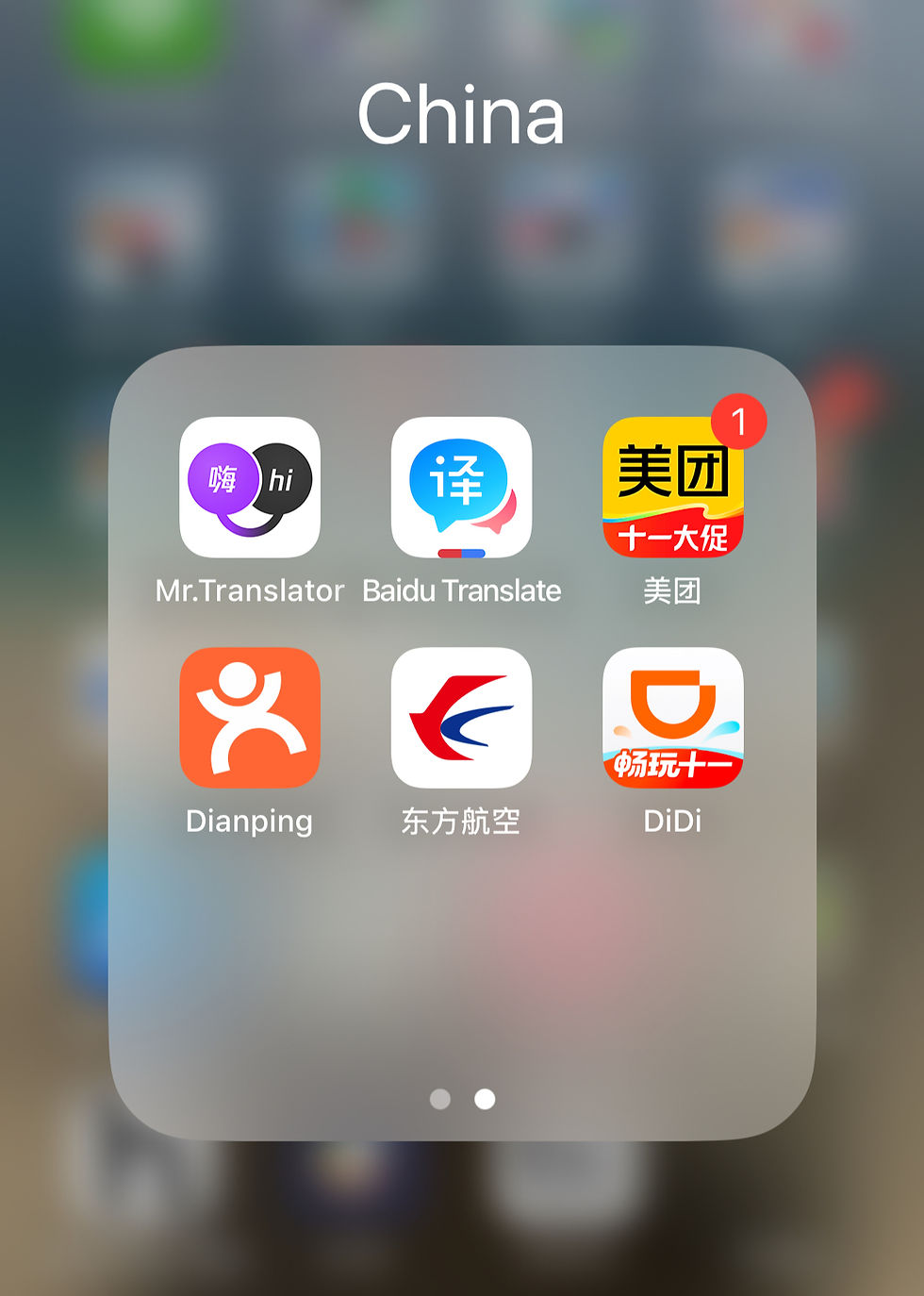🇨🇳 Preparations for Your Trip to China: Apps, VPN, eSIM, and More
- hummblylife
- Oct 18
- 5 min read
Introduction
A trip to China can be an incredibly enriching experience, but it requires some preparation. In this guide, you'll find essential tips on connectivity, communication, payment methods, and digital tools to make your experience much smoother.
👮🏻 Visa and Arrival Card
✅ Visa: Before traveling to China, check whether your country requires a visa. Most travelers need to obtain one at a Chinese consulate or visa center before their trip. Temporary exemptions or transit visas (72 or 144 hours) are available in certain cities like Beijing or Shanghai. In our case, with Chilean passports, we were able to visit for 30 days without applying for a visa. For more information, check official sources.
🛂 Passport: Make sure your passport is valid for at least six months from your entry date and has several blank pages for stamps or visas.

📋 Arrival Card
Upon arrival, you must fill out the arrival card (available in physical form or digitally at airport kiosks). This includes personal details, flight number, and accommodation address.
💡 Tip: You can fill it out online in advance to save time. You will receive a QR code per person, which you must save and use to print physical cards.
Airports with self-service kiosks to print the physical arrival card:
Shanghai Hongqiao International Airport (SHA)
Shanghai Pudong International Airport (PVG)
Chongqing Jiangbei International Airport (CKG)
Xiamen Gaoqi International Airport (XMN)
Hangzhou Xiaoshan International Airport (HGH)
Ningbo Lishe International Airport (NGB)
Qingdao Jiaodong International Airport (TAO)
Jinan Yaoqiang International Airport (TNA)
Wuxi Shuofang Airport (WUX)
Dalian Zhoushuizi International Airport (DLC)
If you arrive at another airport not listed, or are unsure whether they have kiosks, you can simply fill out the physical card.
📱 Connectivity: eSIM or Physical SIM
Recommended options:
International eSIMs (Airalo, Holafly, Nomad): If your phone is compatible, the most convenient option is to purchase, install, and use an eSIM.
We bought two from different providers and highly recommend it because the eSIM automatically allows access to websites normally blocked in China (Google, Instagram, YouTube, etc.) as it uses roaming service. After trying Nomad and Trip eSIMs, we recommend Trip’s version because it offers unlimited data options.
Recommendation: eSIM 5G for use in China offered by Trip.com
Install your eSIM before landing to have internet immediately. Follow your provider’s instructions.
Local Chinese SIM: Can be purchased at airports or official telecom stores.
🔒 VPN: Unrestricted Access
Why use a VPN in China? Many apps and websites like Google, Instagram, or WhatsApp are restricted. In our case, we didn’t need one because the eSIM worked, but if you are traveling for work and need hotel or public Wi-Fi, install and test a VPN before traveling.
Download and install before arrival to avoid problems.
📲 Essential Apps for China

Maps:
Baidu Maps (百度地图)
Apple Maps also works well for walking directions
Payment:
Food:
Meituan - Food delivery (similar to UberEats).
Transport:
Didi (滴滴出行) - make sure to download the correct version from App Store!

Translation:
Google Translate (if you have VPN or you are using eSim)
Planning & Guides:
Trip.com - To book hotels, activities and museums.
Klook.com - tours like Mutianyu Great Wall; English service is almost guaranteed
Dianping - reviews for restaurants, hotels, and activities
Airline app, e.g., China Eastern Airlines for check-in and boarding passes
Xiaohongshu Little Red Book - recommendations, itineraries, restaurants. Similar to Instagram and Pinterest.
携程旅行 - CTrip for booking hotels, train tickets, etc.
💰 Money and Digital Payments
China is mostly cashless, though some parks may prefer cash (e.g., boat rentals).
Activate WeChat Pay or Alipay and link your card before traveling.
Bring some cash: we carried approx. 800 RMB for a family of 4 for one week, and had some left over.
🧳 What to Pack
First-aid kit: paracetamol, cold/flu medicine, stomach remedies (vomiting, diarrhea). Antihistamines if needed.
Umbrella or rain jackets (hotels often provide umbrellas too)
Comfortable shoes
Weather-appropriate clothing, layered (climate varies widely between regions and seasons). For Nov–Feb, bring a very warm coat, especially in northern cities.
Foldable bags for shopping or souvenirs
🔌 Plugs and Chargers
Plug types: A, C, I
Voltage: 220 V
Bring a universal adapter


Note: Some places prohibit bringing external phone batteries (power banks). Portable rental batteries are available in many cities.
Final Travel Tips
Save reservations offline (hotels, trains, flights) in PDF.
Learn basic Chinese phrases:
Phrase | Pinyin | English |
你好 | nǐ hǎo | Hello |
谢谢 | xièxiè | Thank you |
早上好 | zǎo shang hǎo | Good morning |
洗手间在哪里? | Xǐshǒujiān zài nǎlǐ? | Where is the bathroom? |
这个多少钱? | Zhège duōshǎo qián? | How much is this? |
请问,地铁站在哪里? | Qǐngwèn, dìtiě zhàn zài nǎlǐ? | Excuse me, where is the subway station? |
Travel insurance: highly recommended especially for longer trips
Tap water is generally not safe; drink bottled water
Restaurants: first question as you go in is usually: How many people? You can say it English/Chinese or indicate number of people with your hands; scan QR codes on tables for ordering/payment; prepare dietary notes for allergies if needed.
Bring a fork if your children aren’t used to chopsticks
Climate: Check local weather; it varies greatly across China. For e.g we travelled from Shanghai to Beijing, it was 30+ degrees celsius in Shanghai, and 12 degrees C in Beijing.
Transport:
Subway is convenient, cheap, and easy to navigate; avoid rush hours
Didi is great for families. But during days of extreme weather, or heavy rain, do consider extra time of waiting for a Didi. Last time we had really heavy rain in Beijing, it took us more than 40 minutes for a Didi to arrive. Consider changing your final destination point (a few blocks north/south, etc.) if needed, it might be the case that there's restricted drop/off - pick/up in the area you are wanting to go.
Bathrooms:
Carry toilet paper and hand sanitizer. Some public bathrooms may not have supplies.
Passport: Always carry it; many places require it.
🧳 Quick Checklist
✅ Passport & visa
✅ VPN installed
✅ eSIM active
✅ Essential apps downloaded
✅ Universal adapter
✅ Digital & printed copies of documents
🧡 We hope this guide helps you plan your trip to China smoothly!
Share with friends and family, and follow us on Instagram for more tips.
















































Comments